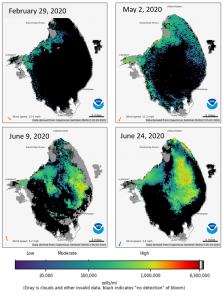June 26, 2020 – updated
Summer is officially here and so too is the near-annual cyanobacterial bloom on Lake Okeechobee. Algal blooms are typical in Lake Okeechobee and usually form in the end of spring and early autumn. This year is no exception. A cyanobacteria (cyano) bloom was first visible by satellite along the western shore of Lake Okeechobee as early as January although it didn’t increase much until late April/early May. Since then, it has continued to expand and currently covers approximately 250 square miles or one-third the surface of Lake Okeechobee.

Cyanoblooms are an annual occurrence in Lake Okeechobee. Because cyanobacteria are photosynthetic they require sunlight to grow. Blooms tend to dominate in the marshy littoral zone along the western edge of the lake. This nearshore area is shallower and has better water clarity which allows for more light penetration. Blooms in the pelagic or mid-lake region are less common because the water is usually too turbid. However, heavy rains in late May/early June stirred up the nutrients within the lake making them available to cyanobacteria and algae. The rains also transported nutrients from the local watershed into the lake which facilitated bloom formation along the eastern edge. Prevailing winds pushed the bloom towards the middle of the lake and the recent calm weather has allowed some of the turbid solids to settle out allowing for greater light penetration in the pelagic region.
Many of the cyanoblooms in Lake Okeechobee are dominated by the species Microcystis aeruginosa. But according to water samples collected from the lake over the last month, the current bloom appears to have a mixed assemblage, with M. aeruginosa and Cylindrospermopsis raciborskii co-dominating the bloom. According to the state Algal Bloom Dashboard, microcystin toxins have been detected at a few locations but the toxins associated with C. raciborskii, anatoxin-a and cylindrospermopsin, have not been detected. Of note, site L004 had a recorded microcystin level of 800 micrograms/L, a value that is 100 times greater than the EPA’s recommended concentration for recreation and swimming. The most recent set of water samples were collected on June 25th and toxin results are pending.
Although there is concern for the potential and unknown human health impact of cyanoblooms, algal blooms on Lake Okeechobee usually raise attention when freshwater discharges from the lake threaten the water quality of the Caloosahatchee and St. Lucie rivers and estuaries. Due to low lake levels, regulatory discharges to the canals have been limited. In fact, until recently, the St. Lucie (C-44) canal had been flowing back, allowing some of the excess local basin runoff to flow into Lake Okeechobee rather than out the S-80 structure and into the St. Lucie Estuary. That recent higher than average rainfall, however, has led to a one-foot increase in lake stage over a period of just one month. If heavy rains continue, as are predicted for the region, regulatory releases may need to occur. It is too soon to predict what will happen with the bloom and how, if at all, it will impact the coastal estuaries.
 1
1
